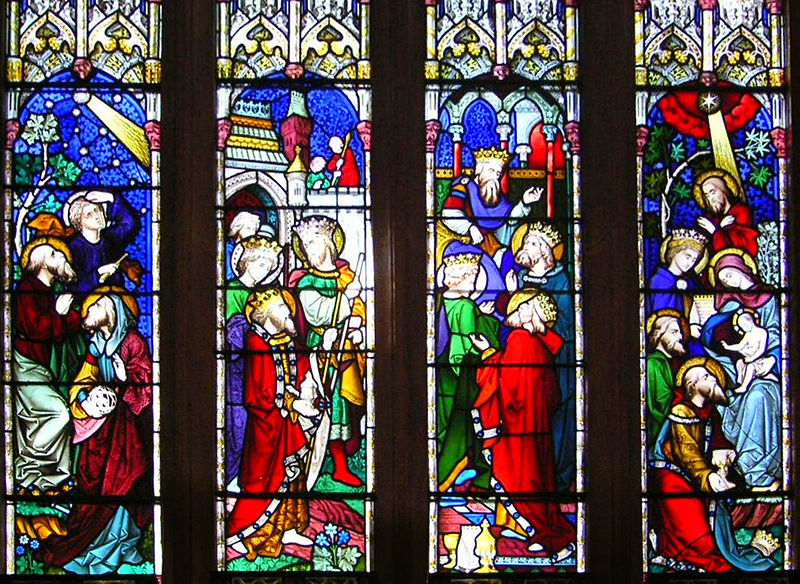![800px-St_Andrews_Cathedral_Sydney_Magi_01[1]](https://mysteriouswritings.com/wp-content/uploads/2012/12/800px-St_Andrews_Cathedral_Sydney_Magi_011-300x219.jpg) One of the few known facts about the mystery of Rennes le Chateau was that the Grand Parchment’s code could not have been solved by using computers like Gerard de Sede was believed to have said. However, maybe this isn’t a fact any longer. It all depends on the definition of the word ‘computer.’
One of the few known facts about the mystery of Rennes le Chateau was that the Grand Parchment’s code could not have been solved by using computers like Gerard de Sede was believed to have said. However, maybe this isn’t a fact any longer. It all depends on the definition of the word ‘computer.’
Although the authenticity of two Rennes le Chateau parchments which contained encoded phrases is questioned, one can still consider a possible purpose or reasoning for their creation. Even a hoaxer’s invention or copy may hold a Truth to be found. If they were all part of an elaborate scheme, as some people think, why did those involved produce the particular codes used on the parchment? Is there a hidden message, not only in the words revealed, but in the process unveiling them?
In the book Holy Blood, Holy Grail (Dell Publishing 1982), Henry Lincoln shares that Gerard de Sede had told him the cipher of the Grand Parchment was broken ‘by experts of the French Army Cipher Department, using computers’. To consider just this one statement leads to some interesting speculations.
With the necessary arbitrary steps taken in order to crack the code, it would seem probable De Sede knew a computer could not have been used to decipher the hidden message. Possibly assuming a computer (as commonly understood) would be proven as a false method, could De Sede’s statement about its use have been a hint towards a different meaning for a computer? Nothing seems clear cut when it comes to those who are part of the Rennes le Chateau and Priory of Sion mystery; and the play with words often appears.
In De Sede’s own book, The Accursed Treasure of Rennes le Chateau (translated by Bill Kersey, DEK Publishing, 2001), he even writes about the importance for cloaking meanings with the play of words. A page before discussing the parchments, he wrote the following:
“For such a man the only way out would be to speak while taking care not to be understood, or to be understood while ensuring that certain aspects are never overtly mentioned.”
When De Sede mentioned the computer being the method used for deciphering the parchment, could he have been ‘covertly mentioning’ an actual process for revealing secret writings? Included in the Gentleman’s Magazine (1857, vol.202) is one of the first definitions for a computer. De Sede discussed the significance of discovering word origins in his book (The Accursed Treasure of RLC) and it is possible the original understanding for computer was his intention. This early form of computer was defined as ‘a device which serves as a substitute for human intelligence in the combination of figures’ or described as a device which does not rely on the man’s own understanding. Could he have been alluding to Proverbs 3:5 where it says “Lean not on your own understanding”?
I found this possibility intriguing because of certain ideas released in the Time Monk Project. The Key for the Maranatha puzzle, a device claimed to be the one referred to in the decoded message of the Grand Parchment, was given as a hexagram on a tilt. Previously released in the project, were PDF’s which depicted the representation of the Tree of Life found within the images of the Maranatha book. This illustration can be seen to include both the hexagram and pentagram combined to form the depiction. As it is known, the pentagram is commonly used to symbolize Man. If the pentagram/man attached himself to the Key (which is given as a leaning hexagram), could it be said, Man would be leaning not on his own understanding, but the ‘Key’s?’ Together, like a circuit, the Tree of Life and the paths to the Divine are completed.
As the above is a potential application for the Maranatha Key, it is interesting to note how the suggestion of De Sede for using the ‘computer’ could imply the same or similar purpose. The computer does not rely on solely man’s understanding, but something ‘more’, in order to complete ‘computations.’ The tilted hexagram (representing leaning on not man’s own understanding but possibly God’s Word or the Star of the Magi) could be seen used in the process to solving the codes.
Whatever the reasoning for De Sede to have said a computer was used in deciphering the parchments, may never be known for certain. However, considering the fuller meaning for the word computer does open up some unique paths to explore. If one continues to contemplate the possibility, then the Key mentioned in the Grand Parchment phrase could imply there is more to do with it.


I think the point was that it couldn’t be solved by a computer without knowing the key. Knowing the key, it probably could have been solved with pen and paper or very simple devices.
The hexagram with the square was almost certainly needed to solve the code, if it was a Masonic code, as has been intimated. But the correct position of it isn’t usually tilted as it was shown. It could well have been the star of the Magi, but I’m not sure of that.
The figure to be attached to the hexagram in a square isn’t a single pentagram, but four.
Actually, I’m not sure that you are meant to attach the pentagram to the hexagram at all.
I’m not sure where you see a pentagram in the tree of life.